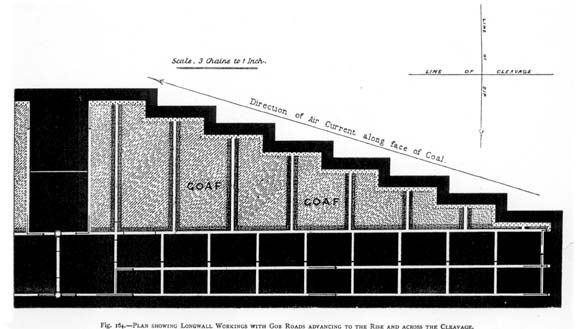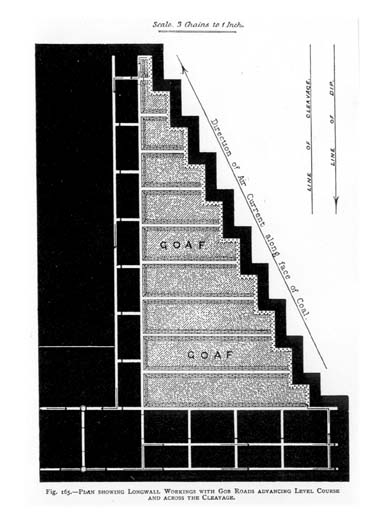
The advantages of working the Longwall where it is applicable are, a better yield of large coal, less injury to upper seams as the intermediate strata settle gradually, simplicity of working, ease of ventilating, and greater economy, for the superincumbent weight reduces the labour of "holing." These advantages are so manifest as to indicate the desirability of working all seams of usual thickness situated 100 fathoms or more below the surface on the Longwall system. There are many modifications of Longwall, and this is one of its merits; it is capable of being varied more readily than the Post and Stall to suit local circumstances. In all cases it consists of extracting all the coal at one operation, the roof settling down behind as the "face" advances. In practice it is generally found better to take out all the coal with the exception of the shaft pillars, but sometimes pillars are left between, and on each side of, the main roads. There is an advantage in letting the face advance across the cleavage of the coal, but some coals have no defined cleavage, and sometimes, even where there is a cleavage, the dip is not suitable for the face to advance across it. In Fig. 164 the gob roads are carried to the rise and across the cleavage of the coal. The distance of these gob roads apart varies, being seldom under 14 yards or over 50 yards. The roads are carried in the middle of the stall, for convenience in working the coal and in bringing it from both sides as shown on the plan, Fig. 164. The pack-walls are built as shown, and if the seam be thin, height is made by ripping either top or bottom. The gob must be packed with the rubbish yielded by the seam in being worked and by the rippings, and the closer it is packed the better will be the result. This is especially necessary in fiery seams, for it must be remembered that any portions of the waste not closely gobbed afterwards become receptacles for fire-damp, unless ventilated. At times, when the barometer is low, a portion of this gas finds its way into the roads, and is at all times a source of dread and anxiety. If the roof is bad a double row, and sometimes a treble row of props, with lids placed over them, is kept next the face, the back ones being taken out, where this can be done with comparative safety, and re-set in front as the face advances. In some cases a double row of chocks is used instead of props. Often the water levels from the shaft, instead of running in a line with the cleavage as shown in Fig. 164, will cross it at some angle; if this be a right angle and it is desirable to carry the "face" across the cleavage, Fig. 165 shows the method usually adopted.

| The face thus advances against the cleavage, and if the dip and rise be rather great there is an advantage in keeping the gob road at or near one end of the working face [p.162/163] instead of in the middle, so that the coal may be brought "down hill" to the road. In very tender seams, there is an advantage in working the face with the cleavage, instead of against it, and frequently, where there is no cleavage in the coal, the face, instead of being marked out in steps, is connected [p.163/164] from one gob road to another in curved lines. If ventilation alone be considered, it is of the utmost importance to have the whole face in a straight or gradually curved line, as this arrangement offers less obstruction to the passage of the air in its course along the face. Whilst fully admitting the importance of ventilation, other points have to be considered and kept in view, and it is not always practicable to keep a face of this shape advancing. |  |
Where there is plenty of capital at command, and the area to be worked over is not great, the levels may, with economy, be driven to the boundary of the royalty and the coal worked back towards the shaft, goaf, which is the most dangerous part of fiery mines being thus left behind.